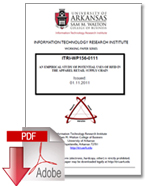It’s hard to imagine that nearly 10 years has passed since Walmart shined a spotlight on RFID technology in the retail supply chain.
Fast forward a decade, and department store leader Macy’s is two years into an aggressive roll-out of RFID technology.
The two initiatives couldn’t be more different from one another. First announced in 2003, Walmart tagged cartons and pallets to speed up the receiving process in its distribution centers.
The ROI was expected to come from automatically reading all those cases and pallets as they passed through an RFID portal at the dock doors. Tagging individual items in the store was way off in the future.
Macy’s, on the other hand, launched its initiative in 2011 in the store. Instead of tracking cases and pallets—something we don’t hear much about these days—Macy’s is using RFID technology to maintain an accurate inventory of the items that are replenished in the stores on a regular basis, a group of products that represents about 30% of Macy’s business.
Having a more accurate inventory is leading to an increase in sales of those items. In the future, the technology may be extended back to Macy’s distribution centers. But then again, maybe not. It’s as if the two retailers both took a look into the future, but from the opposite ends of the telescope.

Why the different approach? Electronic data interchange (EDI) and bar code scanning do a pretty effective job of tracking inventory in the distribution center, says Bill Connell, Macy’s senior vice president for logistics and operations.
Now, however, Macy’s is using its stores for brick-and-mortar sales and as potential fulfillment centers for orders received on the Web or from mobile devices. If the inventory system says a pair of women’s shoes is on the selling floor at the Natick Mall outside Boston, those shoes need to be on the floor. RFID is providing that level of visibility.
“We are leveraging our assets across all sales channels,” Connell says. “We are integrating every opportunity our customer has to interact with us. Anything she wants, anywhere she wants and any time she wants. That implies a lot of changes for us as we think about operational and logistical activities.”
RFID in the retail context
Macy’s may be at the head of the pack when it comes to the adoption of RFID, but it is part of a broader initiative by major retailers that has been in development for a decade, says Bernie Hogan, senior vice president of emerging capabilities and industries at GS1 US, the standards organization.
“When we created the Gen II standard, market leaders like Walmart and the Department of Defense committed to adopting the technology to lower the price of the tags,” Hogan says.
The initial focus on cases and pallets was in part a result of the limitations of the technology. “Back then, tagging cases and pallets in the distribution center were the only things that were practical from the standpoints of the cost of the technology and changing business processes,” Hogan adds.
There were limitations to the technology at the time. “When we moved from bar codes to passive RFID tags, we lost the ability to track where we were in the process,” explains Phil Gerskovich, senior vice president of new growth platforms for Zebra Technologies.
“If you scanned a bar code on the receiving dock, the warehouse management system (WMS) knew that you were at dock No. 7 and initiated the receiving process. RFID allowed you to read tags from a distance, but you didn’t know whether you were receiving, shipping, staging or something else.” What’s more, Gerskovich says, the first generation of tags and readers were not as accurate as they needed to be to drive an ROI.
“We’re enabling higher sales, greater efficiencies and lower costs with RFID. Those are wins, wins, wins.”Bill Connell, Macy’s senior vice president for logistics and operations
That doesn’t mean there weren’t successes. Hogan points out that about 70% of the Department of Defense’s inbound cartons and pallets have an EPC tag today.
What’s changed is that the technology is better, the cost as better and its easier to change business processes. “The business case is clear,” Hogan says. “Macy’s, for instance, is tagging a narrow category of merchandise where it can show an immediate lift in sales.”
What’s more, retailers like Macy’s aren’t launching their initiatives in isolation. They and their suppliers are working within the context of standards established by GS1 US, much as they did with bar codes 40 years ago. “You don’t want Retailer A asking for it one way and Retailer B asking for another,” Hogan says. “By working with a standard, the industry is arriving at shared value.”
Accurate inventory
For Macy’s, the value comes from improving the accuracy of its inventory. In the distribution center, the combination of a warehouse management system, bar code scanning at each step of a process, and regular cycle counts delivers inventory accuracy rates of 95% or better.
The store is a different environment. A retailer like Macy’s typically takes a full inventory in January, after the holiday selling season and before spring merchandise begins to roll into the stores. After that, it’s downhill.
“We know that the accuracy of the inventory deteriorates by a rate of 2% to 3% a month,” says Connell. There are a number of reasons for that degradation, ranging from theft to the way items are checked out at the register. By the start of the holiday selling season in November, most retailers’ inventory count is between 60% and 70% accurate at the floor level.
“Just as you’re going into your peak selling period, you’re inventory is the most inaccurate,” Connell says. That inaccuracy leads to a loss of sales: Customers don’t know that there’s inventory in the stock room, for instance, if the shoe samples aren’t on display.
Inventory accuracy was the catalyst for Macy’s RFID initiative. The groundwork was laid in 2009, when one of the company’s vice presidents tagged every item in a Bloomingdale’s store in the Soho section of Manhattan. Macy’s shared the data collected from that experiment with the RFID research center at the University of Arkansas.
After an analysis, the university identified up to 60 potential use cases for RFID at the item level. The most promising was the unique ability to count much faster and accurately at the item level than was possible or practical with a bar code scanner.
Based on the Soho project, Macy’s launched a broader RFID pilot in a select group of Bloomingdale’s and Macy’s locations in 2010. The new pilot focused on improving the inventory accuracy of three categories that are frequently reordered: denim, men’s basics and women’s intimate apparel.
Using RFID, Macy’s discovered it could easily perform multiple cycle counts throughout the year and that on average, inventory accuracy could be maintained at 97% or better. Frequent counts also led to the correct placement of items in the right range of sizes, colors and styles on the selling floor. The combination led to an increase in sales of those items being tagged.
In August 2011, Macy’s announced that it would adopt RFID technology in its Macy’s and Bloomingdale’s stores on an accelerated timeline. The goal was to begin using RFID in all stores nationwide to count “size-intensive replenishment goods—those items regularly stocked and automatically re-supplied as they are sold to customers” by the third quarter of 2012.
Eighteen months later, Connell says the system is in place, and stores are now tagging and reading all of the replenishment items it sells—everything from housewares to shoes to children’s wear. “We’ve spent the past two years writing the software and deploying the systems that stand behind RFID,” Connell says.
“With an RFID reader, we can scan the Levi’s wall and realize what’s in the backroom that should be on the floor.” The scan also automatically updates the store’s inventory files. That information is used to generate a more accurate replenishment order.
RFID is also being used to maintain an accurate inventory of furniture and bedding in DCs. “We sell furniture and bedding from samples on the floor and ship from our DCs,” Connell says. “With RFID, we can take an inventory in the DC on a daily basis to ensure that we know where every piece of furniture is in the facility.”
While Connell declined to reveal sales numbers, he says Macy’s has recorded a growth in the top-line sales of the items being tagged. “We went into this with specific expectations for what RFID could do for us in terms of top-line sales and reordering,” he says. “What I can say is that the deployment has met our expectations and in some instances exceeded them.”
Beyond replenishment
One of the most challenging aspects of early RFID deployments was getting suppliers to agree to tag cartons and pallets at their facilities. Their gripe was simple: What’s in it for us?
Macy’s has pushed the tagging process downstream to its suppliers. The difference, Connell says, is that there is something measurable in it for the suppliers—more sales.
“We’re enabling higher sales, greater efficiencies and lower costs. Those are wins, wins, wins,” Connell says. “If you focus on that, the case to invest in the technology is a simple one.”
Another challenge was the cost of the tag. The No. 1 question back then was: When will we see a 5-cent tag?
Macy’s focus on top-line sales growth mitigates the cost of the tag. “The question we ask is: What’s the cost of inventory inaccuracy in labor costs, missed sales opportunities and margin erosion?” Connell says. “If you’re able to sell three additional $40 items because of more accurate inventory, it doesn’t matter whether the tag costs 5 cents, 8 cents or 10 cents.”
For now, Macy’s is content to use RFID in the stores rather than extend it to the cases and pallets coming into its DCs. “We don’t think of RFID as a technology in search of a problem,” Connell says. “EDI and UCC128 processes have been refined over the years and work quite well.
We won’t roll out RFID in a new area unless there’s a problem to be solved.” Still, he can foresee extending the RFID solution across more SKUs in the future, especially as Macy’s incorporates more and more of its stores as fulfillment centers for online orders.
The most important lesson, Connell adds, is that Macy’s approached this project from the view of how to better serve customers. “Any decision we make is made through the prism of what does our customer want,” Connell says. “Answering that question is central to everything we do as a company, including initiatives like RFID.”
More RFID Resources
-RFID Helps Lord & Taylor Capture More Sales
-American Apparel Finds the Right Fit with Motorola RFID
-Retailers are Driving RFID Adoption and Propagating the Benefits Throughout their Supply Chains
-Item-level RFID: A Competitive Differentiator
-Source to Store - Leveraging EPC®-Enabled RFID Throughout the Supply Chain
About the Author
Follow Robotics 24/7 on Linkedin
Article topics
Email Sign Up
















